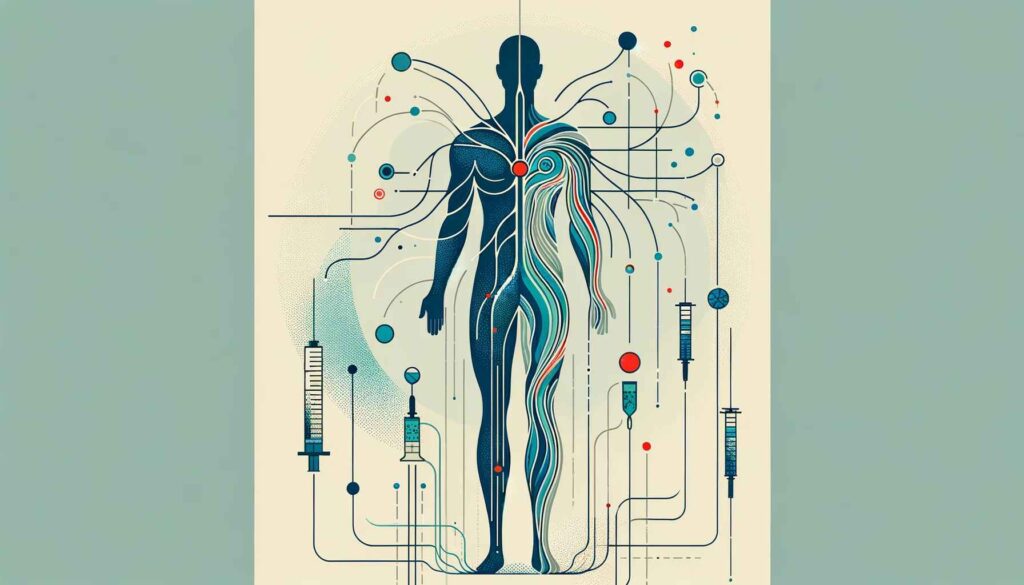In the dim light of an early morning, a young man named Alex finds himself in the quiet corner of a park, his hands trembling as he prepares for his daily ritual. Despite his efforts to be cautious, his lack of access to clean needles and a safe environment leaves him vulnerable, a reality faced by millions globally. In cities and towns around the world, countless individuals, much like Alex, engage in unsafe injection practices, a decision often made out of necessity rather than choice. The consequences are dire and far-reaching, contributing to a staggering 13% of new HIV infections worldwide being attributed to needle sharing among people who inject drugs (PWID). Beyond the risk of HIV, unsafe injections pave the way for hepatitis C outbreaks, bacterial infections, and a myriad of other health complications, casting a long shadow over communities.
Enter the philosophy of harm reduction, a beacon of pragmatism in the stormy debate over drug use and policy. At its core, harm reduction acknowledges the complex reality of drug use—it does not condone nor condemn but seeks to mitigate the adverse health and societal impacts associated with these behaviors. This approach is not about encouraging drug use; instead, it’s about recognizing that drug use exists and choosing to prioritize health and safety over moral or legal judgments.
The significance of harm reduction in the realm of injection drug use cannot be overstated. It addresses the immediate health needs of PWID, offering a lifeline to some of the most marginalized individuals in society. By reducing the incidence of bloodborne infections, harm reduction strategies can also alleviate broader public health burdens, such as the spread of infectious diseases and the high costs associated with long-term healthcare for chronic conditions.
Common Risks of Unsafe Injection Practices

Unsafe injection practices present a host of risks, both to the individual engaging in drug use and the community at large. These include:
- Transmission of Bloodborne Infections: Sharing needles and other injection equipment is a primary route for the transmission of HIV, hepatitis B, and hepatitis C. These viruses can survive in syringes and on surfaces, making even casual sharing dangerous. The impact of these diseases is profound, with long-term health implications and significant mortality rates.
- Injection-Related Injuries: Unsafe injection can lead to a range of injuries and medical conditions, including abscesses, vein damage, and infections at the injection site. Repeated injections under non-sterile conditions increase the risk of these complications, leading to chronic pain, mobility issues, and in severe cases, amputation.
- Increased Risk of Overdose: The lack of a safe and controlled environment for drug use heightens the risk of overdose. In situations where individuals are using drugs in hidden, hurried conditions, there’s less opportunity to measure doses accurately or seek help in the event of an overdose.
By ensuring that individuals who inject drugs have access to the necessary resources and support, harm reduction initiatives work to protect the health of PWID and, by extension, the health of the community. This approach not only saves lives but also fosters a more compassionate and effective response to the complex issue of drug addiction and its societal impacts.
Physiology of Intravenous and Intramuscular Injection

Understanding the physiology behind intravenous (IV) and intramuscular (IM) injections is crucial for minimizing harm and ensuring the effectiveness of the substance being used. Both methods involve delivering substances directly into the body but differ in their specific targets and absorption rates. There are also other ways and techniques of injection (for example, subcutaneous), but we will mostly focus on the above as the most common.
Intravenous (IV) Injection
Intravenous injections involve delivering a substance directly into the bloodstream through a vein. This method is used for its immediate effects, as the injected substance is rapidly distributed throughout the body via the circulatory system. The rapid onset is because the drug bypasses the digestive system and liver metabolism (first-pass metabolism), allowing the active compounds to reach their target sites without being altered.
Physiology and Considerations:
- Venous System: Understanding the venous anatomy is crucial for selecting an appropriate vein for injection. Veins closer to the surface of the skin are typically used for IV injections.
- Rapid Effect: Since the drug enters directly into the bloodstream, the onset of action is quick, making dosage and rate of injection critical factors to manage to avoid adverse effects.
- Risk of Infection: IV injections carry a risk of introducing pathogens directly into the bloodstream, making sterile techniques paramount.
Intramuscular (IM) Injection
Intramuscular injections are given directly into muscle tissue. The muscle tissue has a rich blood supply, allowing the drug to be absorbed into the bloodstream gradually compared to IV injections. This slower absorption rate can provide a sustained release of the medication over time, making IM injections suitable for vaccines, hormonal therapies, and long-acting medications. There are also other ways and techniques of injection (for example, subcutaneous), but we will focus on the above as the most common.
Physiology and Considerations:
- Muscular System: Selecting the appropriate muscle, based on the volume of the substance to be injected and the physical condition of the patient, is important. Common sites include the deltoid (upper arm), vastus lateralis (thigh), and gluteus medius (buttock).
- Absorption Rate: The absorption rate of the drug depends on the blood flow to the muscle and the solubility of the medication. Factors like muscle mass, physical activity before and after injection, and the site of injection can influence how quickly the drug enters the bloodstream.
- Less Immediate Effects: Because the drug is absorbed through the muscle tissue into the bloodstream, the onset of action is slower than IV injections but faster than subcutaneous injections.
Proper Injection Technique. Step by Step
Proper drug injection technique is crucial for ensuring the medication’s effectiveness, minimizing pain, and reducing the risk of complications such as infections or tissue damage. Whether administering an injection to yourself or another person, following a step-by-step process is essential for IV or IM injections. Here, we’ll focus on a general overview that can apply broadly, with the understanding that specific medications might require slight adjustments to this procedure.
Preparation
- Wash Your Hands: Begin by thoroughly washing your hands with soap and water to minimize the risk of introducing bacteria or viruses into the injection site.
- Gather Your Materials: Prepare the medication, a new sterile syringe and needle, alcohol swabs, a sharps disposal container, and any other required materials. Ensure the medication is at the correct temperature and check the expiration date.
- Select the Injection Site: Choose an appropriate site based on the type of injection. For IV injections, choose a vein that is visible, accessible, and in good condition. Rotate sites to prevent vein damage; for IM, common sites include the deltoid, vastus lateralis, or gluteus medius; for subcut, the abdomen or thigh is often used.
Preparing the Injection
- Sanitize the Injection Site: Use an alcohol swab to clean the skin in a circular motion, starting at the center and moving outward. Allow the skin to air dry to reduce the risk of irritation.
- Prepare the Medication: Further steps may vary depending on the specific substance, but most importantly, you need to use clean spoon or coocker, and sterile water
- Use Filter: The most important thing at the preparation stage is filtration. It is necessary to filter the solution to exclude pathogens and pollutants from entering the body. For filtration, you can use sterile cotton wool, a sterile tampone or special products like Sterifilt FAST. Place filter in drugs, place needle in filter, and draw liquid into needle.
- Remove Air Bubbles: Hold the syringe upright and tap its side gently to encourage any air bubbles to rise to the top. Gently depress the plunger to expel these bubbles. Air bubbles in the syringe can lead to air embolisms if injected, especially in IV administration.
Performing the Injection
- IV Injection: Use a tourniquet to make the vein more pronounced, but release it before injecting to reduce pressure in the vein and minimize damage. Insert the needle at a 30-45 degree angle with the bevel facing up. Once you see blood enter the syringe (flashback), you’re in the vein. Slowly inject the medication, then remove the needle and apply gentle pressure to the site with a clean swab.
- IM Injection: For IM injections, insert the needle at a 90-degree angle to ensure it goes deep into the muscle. Inject the medication slowly, then withdraw the needle and apply pressure with a clean swab to stop any bleeding.
- Subcutaneous Injection: For subcut injections, pinch the skin to create a fold and insert the needle at a 45-degree angle. Inject the medication slowly, then remove the needle and release the skin.
Post-Injection
- Dispose of the Needle Safely: Immediately place the used needle and syringe into a sharps disposal container. Never reuse needles or syringes.
- Monitor for Reactions: After the injection, observe youself for any adverse reactions to the drug, following any specific post-injection harm reduction instructions.
Additional Tips
- Using sterile equipment for each injection is non-negotiable. Sterile syringes and needles, alcohol swabs, and clean surfaces reduce the risk of infection, vein damage, and other complications. Sharing needles significantly increases the risk of transmitting bloodborne pathogens like HIV and hepatitis C. Even sharing seemingly less critical equipment, such as cookers and cotton, can pose risks due to the potential transfer of infectious agents.
- Rotate injection sites to prevent tissue damage or irritation.
- Never rush the process; taking your time ensures safety and effectiveness.
Following these steps carefully can help ensure that injections are performed safely and effectively, whether they’re for vaccinations, medications, or other treatments.
Safe Injection Sites

Safe Injection Sites (SIS), also known as Supervised Injection Facilities (SIFs) or Drug Consumption Rooms (DCRs), are legally sanctioned, medically supervised environments where individuals can use pre-obtained drugs in a safer manner. These facilities are designed to reduce the health and societal risks associated with injection drug use. By providing a hygienic and stress-free environment for consumption, SIS play a crucial role in harm reduction strategies.
SIS operate with the primary goal of harm reduction. Their services often include:
- Supervised Consumption: Trained healthcare professionals or harm reduction workers supervise drug use to immediately respond to overdoses or other medical emergencies.
- Access to Clean Needles and Injection Equipment: Providing sterile injection equipment reduces the risk of transmitting bloodborne infections.
- Medical Supervision and Emergency Care: Immediate access to medical care for overdose management or wound care helps prevent complications.
- Referral to Treatment Services: SIS frequently offer or refer individuals to drug treatment services, including detoxification, medication-assisted treatment (MAT), and counseling.
- Education on Safe Injection Practices: Staff provide education on safer drug use, vein care, and overdose prevention.
- Support Services: Many SIS also offer additional services, including basic healthcare, social support, and legal advice.
Effectiveness of Safe Injection Sites
Research on SIS has consistently demonstrated their effectiveness in improving health outcomes and reducing harm among PWID. Key findings include:
- Reduction in Overdose Deaths: Studies have shown that SIS significantly reduce overdose fatalities in their immediate vicinity. For example, Insite, North America’s first SIS located in Vancouver, Canada, was associated with a 35% reduction in overdose deaths in the surrounding area.
- Decrease in Bloodborne Infection Rates: SIS contribute to lower rates of HIV and hepatitis C transmission by providing sterile injection equipment and promoting safer injection practices.
- Increased Access to Health and Social Services: Evidence suggests that individuals who use SIS are more likely to access drug treatment services and other forms of medical and social support.
- No Increase in Drug Use or Crime: Contrary to common concerns, research indicates that SIS do not lead to an increase in drug use or drug-related crime in their areas. In many cases, public drug use and related litter decrease.
The effectiveness of SIS in improving public health and safety, while controversial to some, is supported by a substantial body of evidence. By addressing the immediate health needs of PWID and providing pathways to treatment and support, SIS embody a critical component of comprehensive harm reduction strategies. Their role in saving lives, reducing the spread of infectious diseases, and improving community well-being underscores the importance of expanding these services as part of a holistic approach to drug policy and health care.
Societal and Policy-Level Barriers
- Stigma: Stigmatization of drug use and addiction significantly hinders the implementation of harm reduction strategies. This stigma can manifest in public opposition to SIS, driven by misconceptions that such facilities encourage drug use or attract crime, despite evidence to the contrary.
- Legal Challenges: In many regions, drug use is heavily criminalized, creating legal barriers to the operation of SIS and the distribution of clean needles. These legal challenges not only impede the establishment of new sites but also place clients and staff at risk of legal repercussions.
- Lack of Political Will: Implementing harm reduction strategies requires political courage and commitment. The fear of political backlash can deter policymakers from supporting harm reduction measures, even when evidence supports their efficacy.
- Funding Constraints: Harm reduction programs often struggle with securing sustainable funding. Without financial support, maintaining operational capacity and expanding services to meet community needs become challenging.
Success Stories and Case Studies
Despite these challenges, there are numerous success stories and case studies from around the world that highlight the positive impact of harm reduction strategies:
- Vancouver, Canada: Insite, the first legal SIS in North America, opened in 2003 in Vancouver’s Downtown Eastside. It has significantly reduced overdose deaths in the area and increased the uptake of detox and treatment services, serving as a model for similar facilities worldwide.
- Sydney, Australia: Uniting Medically Supervised Injecting Centre. Since opening in 2001, Sydney’s MSIC has supervised millions of injections and managed thousands of overdoses without a single fatality. The facility has also led to improvements in public order and reduced the number of publicly discarded syringes in the vicinity.
- Portugal: Decriminalization and Harm Reduction. In 2001, Portugal decriminalized all drugs for personal use and shifted its focus towards harm reduction and treatment. This policy shift has led to significant decreases in HIV infections, drug-related deaths, and overall drug use among adolescents.
- Switzerland: Heroin-Assisted Treatment. Switzerland’s heroin-assisted treatment program, which began in the 1990s, provides medical-grade heroin to people with long-term addictions under supervised conditions. This approach has reduced illegal drug use, crime associated with drug addiction, and improved the health and social integration of participants.
These examples demonstrate that with adequate support and a focus on evidence-based practices, harm reduction strategies can lead to substantial health and social benefits. They underscore the need for a shift in perception, policy, and funding to embrace harm reduction as a critical component of public health strategies for managing drug use and addiction. By learning from these success stories, communities and policymakers can overcome barriers to implement effective harm reduction measures that protect and improve the lives of people who use drugs and the communities in which they live.
As we look to the future of harm reduction, it’s clear that innovation, policy reform, and community engagement will be key drivers in expanding and enhancing the impact of these crucial strategies. The evolving landscape of drug use and public health challenges calls for adaptive approaches that leverage new technologies and foster supportive legal and social environments.
A Call to Action

The success of harm reduction depends on the collective efforts of individuals, communities, and policymakers. Here’s how you can contribute to this vital cause:
- Educate Yourself and Others: Challenge myths and stigma surrounding drug use by learning about and sharing evidence-based information on harm reduction.
- Support Harm Reduction Organizations: Volunteer, donate, or advocate for organizations that provide harm reduction services in your community.
- Advocate for Policy Change: Engage with local and national policymakers to support the adoption of harm reduction policies, including the establishment of SIS and the decriminalization of drug use.
- Promote Compassion and Understanding: Foster a community environment that supports individuals affected by drug use, recognizing their dignity and right to health and safety.
The journey towards a safer and more compassionate approach to drug use is ongoing. By embracing innovation, advocating for sensible policy reforms, and supporting harm reduction measures, we can make significant strides in improving the lives of individuals and the health of communities around the globe. Together, let’s move forward with empathy, science, and action at the forefront of our efforts to reduce harm and support well-being.




